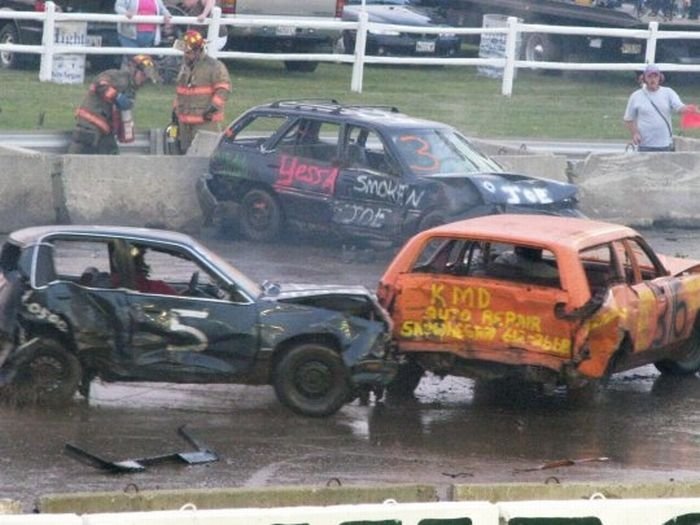|
|
Demolition Derby
|
Competitors have traditionally used full-size, American made sedans, and station wagons, especially those from the 1960s and 70s, which were larger, heavier, and had more robust frames than later full-size vehicles. The 1964-1966 Chrysler Imperial achieved near-legendary status for its crashworthiness, and is still banned from most derby events. Scrap vehicles are purchased from junkyards and private owners, usually for less than US$500, though some select (and rust-free) mid-1970s sedans, and station wagons, may go for more than $1,000. A vehicle may be patched up and re-used for several events.
With the dwindling availability of these older vehicles, smaller full-sized vehicles of the 1980s and 1990s are more frequently encountered today. A separate class of demolition derby for compact cars is increasing in popularity. Compact car events have the advantages of an abundant supply of usable vehicles, which also tend to be more mobile and thus, more entertaining to fans. Being largely front-wheel drive, their back ends can sustain considerable amounts of damage before the vehicle is immobilized. However, this increased speed, coupled with the fact that compact cars tend to be less crashworthy, makes injuries more frequent.
Bizarre versions of the sport using combine harvesters, and lawn mowers have been practiced in various parts of the world. Larger vehicles, such as pickup trucks and SUV's were rarely used in demolition derby (though school bus demolitions have long been a popular exception), but have recently become popular in demolition events. Recently a new class for minivans has been added to some derbies because of the abundance of older vehicles.
The vehicles are stripped of interior fixtures, trim, plastic, lights, and glass. They are repainted, often in loud, garish designs and low budgets (spray paint is frequently used to mark names, slogans and identification). The driver's side door is usually painted a distinct white color, to allow the other drivers to avoid it and to allow numbering. Additional modifications include trimming sheet metal from around the wheel wells, removing parts of bumpers, welding the doors shut, and relocating the battery and gas tank. The radiator is sometimes relocated to the back seat. To make the cars last longer, they are occasionally pre-bent, frames notched, rear bumper removed, trunk lid notched, and rear coil springs are (when rules allow) replaced with leaf springs. In many instances, roll bars, fire extinguishers, and other safety equipment is installed. Sometimes the removed parts create bulk availability of off-color parts for older cars that are compatible with them. In most cases, any vehicle parts must be "stock," though in some derbies a "gladiator" or "outlaw" division allows cars to be extensively modified and reinforced.
|
|









